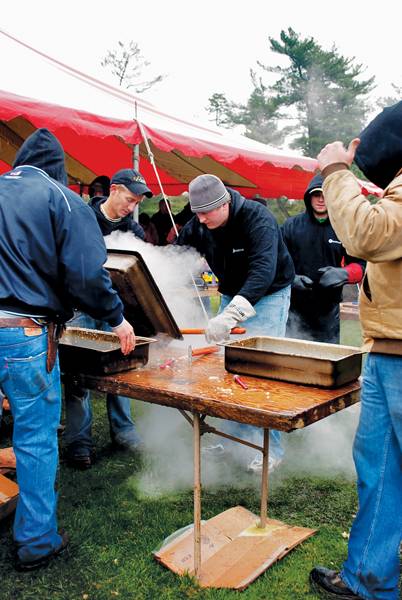Evolution of a tradition

Todd Ellensohn, senior in Agronomy, and Dan Hartmann, junior in agricultural studies, help cook barbeque on Monday on Central Campus. The barbeque will be held every day this week from 11-2 p.m. Photo: Chris Potratz/Iowa State Daily
April 12, 2009
As a young man, Bob Ferguson was drafted into the Army in 1953. He remembers flying a four-motor plane and working as a radar operator near an Air Force base in Fort Bliss, Texas. He said the advancement of technology during his time in the armed forces almost moved too quickly for him to keep up.
“Things have just progressed so fast. Someone like me feels like they’re left behind.” Ferguson said.
But Ferguson, upon returning from active duty, was part of the tradition of Veishea almost every year before retiring.
Ferguson, a 1964 alumnus, remembers the parade as being the highlight of Veishea during the 1960s.
“They did such a tremendous job,” Ferguson said.
Most of the floats were motorized and some were designed to be operated by a person lying down inside. Often, floats were connected, and Ferguson can remember the larger ones struggling to make the turns on the parade route. On the day before the parade, he said, he remembers seeing students staying up late at night to finish the floats.
“Students on the last day worked 24 hours straight on those things,” Ferguson said. “They put in an all-nighter on them to get them done.”
Although Ferguson said people were really intrigued by the floats, the marching bands were also a key feature. He said the bands came from many different schools and made the parade last a long time.
“It was really an honor to be selected to play at the Veishea parade,” he said. “Every band wanted to come.”
Other traditions Ferguson remembers are the cherry pies and Stars Over Veishea. Both traditions are alive and well today, and he said one particular performance of “Fiddler on the Roof” was memorable.
“People who did acting were excellent — they did a great job,” he said. “There were some great students.”
Although many things are the same, Ferguson remembers there being a lot more student involvement — particularly within the campus displays and open houses. As a geology major, he helped with the display in Science Hall, showcasing a miniature geyser and a collection of fossils. He said the displays were a benefit to the department because parents of prospective students would be around to see what might interest their children.
Concerts on a scale similar to those of Live @ Veishea were not planned during Ferguson’s time as a student. He said there was a big dance accompanied by a band, but it wasn’t the highlight of the week.
As a married student, he didn’t really experience the night life of Veishea. However, Ferguson doesn’t remember hearing about parties or issues involving alcohol at night.
“There were no riots,” he said. “Some students even treated Veishea as a vacation and went home.”
Although Ferguson admitted things were more regulated back then, he said times have changed along with the celebration.
Several current students said the focus of Veishea today is different from the Veishea of Ferguson’s time.
“People have been focused on the entertainment at Veishea,” said Amanda Berg, junior in kinesiology. “Even then, I think they’re starting to fizzle out since they implemented the ticket and wristband policy.”
Kyle Wiebers, entertainment co-chairman and junior in management information systems, said the biggest part of Veishea for him has always been the parade. Although the concerts play a big role each year, he said people often associate Veishea with only the concerts.
“We’re trying to unite Veishea and bring it together and show that there’s so much more to Veishea than just the concerts,” Wiebers said.
Liz Dohrmann, freshman in pre-design, will experience her first Veishea celebration this week, but she has a good idea of what it’s all about.
“From what I’ve heard, it’s about the history of the campus, pancakes at two in the morning, cherry pies and drinking,” Dohrmann said.
Ferguson stopped regularly attending Veishea when he retired in the 1990s, but he has four grandchildren who have attended Iowa State and is proud to see third-generation Iowa Staters enjoying the celebration.






